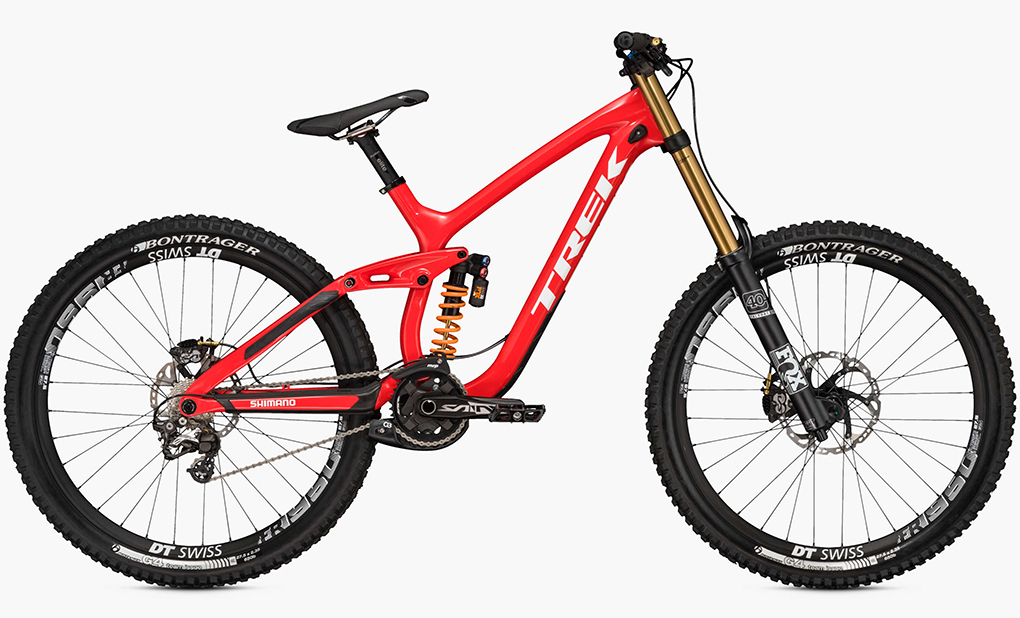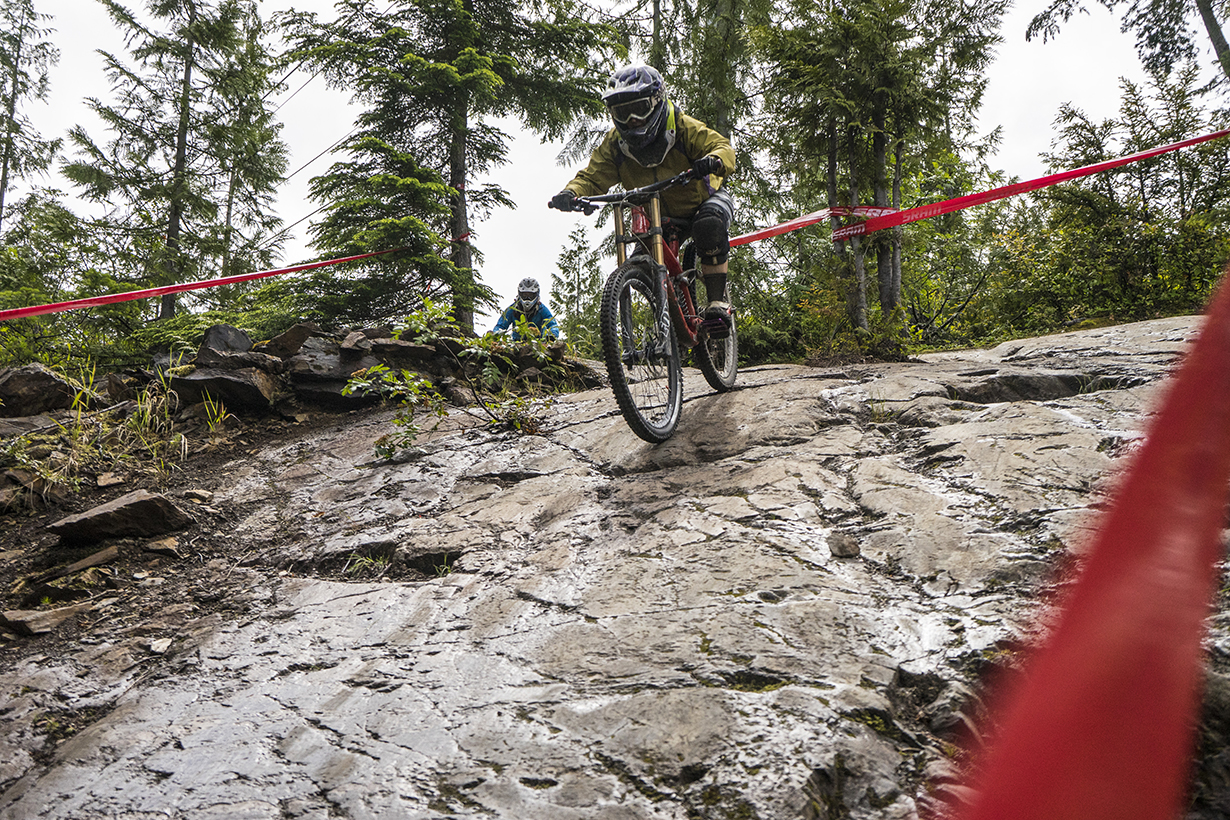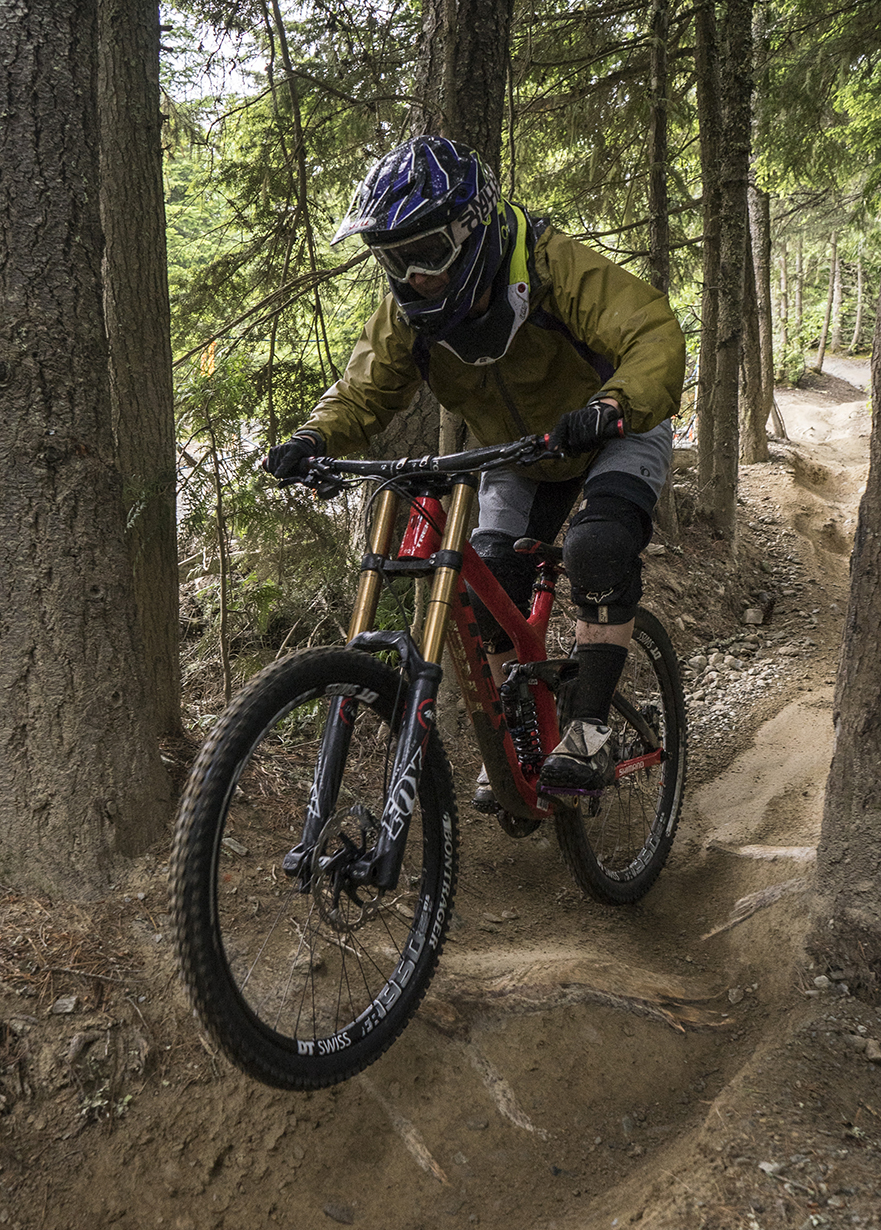Trek Session 9.9
Size Tested: Small
Build Overview:
- Fork: Fox Factory 40 FIT RC2
- Rear Shock: Fox DHX2 SLS
- Drivetrain: Shimano Saint
- Brakes: Shimano Saint
- Wheels: DT Swiss FR1950
Wheels: 27.5′′
Travel: 203 mm Front, 210 mm Rear
MSRP: $8,999
Reviewer: 5’4” 120 lbs.
Test Location: Whistler, BC
Test Duration: 2 Days

On our review trip to Whistler earlier this summer, Noah and I both rode the Trek Session 9.9. We’ve published Noah’s review of the Session 9.9, but as a small female rider, this is my take.
Going into this review, I was excited to unleash my inner Rachel Atherton on the bike that’s helped Rachel dominate this World Cup season. Whether or not I rode any faster is debatable, but the lightweight Session 9.9 helped me conserve energy, and the bike had a few other notable features that stood out.
Build and Frame
The Session 9.9 is Trek’s top-of-the-line carbon version of the Session. Because the Session 9.9 is all carbon, it weighs less than most downhill bikes — and the frame is actually lighter than a lot of trail bikes, too. As a fairly small person, this was the most noticeable thing to me about the Session 9.9. It felt maneuverable, and my small, fairly weak, upper body was less fatigued. I was less tired pedaling, and I could ride more actively (like I would on my trail bike).
The 9.9 runs a Fox DHX2 in the rear and a Fox Factory 40 in the front. Both are highly adjustable, but because the Summit Sport shop in Whistler did an excellent job setting up the bike, I didn’t mess around too much with the suspension (I only adjusted the rebound a bit).

This was the first DH bike I’ve ridden with 27.5” wheels. Maybe it was just psychological, but I felt like there was a noticeable difference in how fast the wheels rolled. They plowed over roots and rocks nicely, although the bike’s light weight required that I stay active to control the bike in techy sections. The 9.9 I rode had DT Swiss FR1950 wheels, which are pretty light given their width and impressive durability.
The Session 9.9 felt smooth over brake bumps, rocks, and tech, which surprised me for a bike that’s so small and light. Part of that definitely has to do with wheel size, but the 9.9 also uses Trek’s Active Braking Pivot suspension system, which is designed to keep the rear suspension active when you’re using the brakes. And to be honest … I use the brakes a lot more than Noah.
The only downside to the 9.9’s weight and size (at least for me) was a limitation I’ve encountered with other small, light bikes. On the one hand, the Session 9.9 was light and required less energy to maneuver. On the other hand, late in the day when I was fatigued, the 9.9 really required that I maintain good form, or I was liable to get tossed around a bit. I wonder if sizing up would help with this, something I’ll touch on in the next section.
Geometry and Fit
In terms of reach and top tube length, the size Small Session felt very small, to the point that I considered sizing up. For a bit of perspective, I’m a pretty small person (5’4”, 120 lbs), and I’ve never ridden a Medium frame — and I’ve actually considered going with a size Extra Small for a couple of downhill bikes.

However, the 9.9’s chainstays are longer than average, making the wheelbase about average for a size Small. As a result, the 9.9 is still pretty stable, despite its short reach. The cockpit feel reminded me of the Kona Entourage (which is similarly small but doesn’t have the longer wheelbase) although the Entourage was much less forgiving.
Despite having a longer rear end, the 9.9 still cornered well. I think this was because the longer wheelbase helped me stay centered over the bike. With some bikes I drift into the backseat, making it harder to control my front wheel. However, the 9.9’s longer rear end kept my weight forward.
Comparisons
I’m currently riding a 2013 Specialized Demo as my downhill bike. Compared to my Demo—which has a fairly light build—I was still less tired riding the Session 9.9. Riding the Demo feels like driving a tank, which has its perks when you’re terrified or exhausted. However, the 9.9 enabled me to move the bike through the trail, instead of just holding on. With the 9.9, I felt more precise and rode significantly better. If I were to pick an ideal race bike from the two, I’d pick the Session 9.9.
The Demo sometimes gets hung up in tech because of its short rear end, whereas the Session 9.9 kept moving through the roots and rocks — though once I got tired, I did notice the bike getting deflected. I had to stay active and focused on the 9.9, when sometimes I might have preferred to just hang on. The more tired I got, the more I appreciated the Demo’s extra weight, which seemed to help it hold a straight line.
Bottom Line
I’m pretty impressed with the Session 9.9, which you’d hope is the case for a $8,999 bike. As I noted above, I think this would be a great downhill race bike.
As someone who shuttles and is fairly prone to crashing, I would consider getting the aluminum Session 88 ($4,999.99). The increased durability and smaller price tag are appealing, though the Session 88 also has a stated weight of 37.5 pounds in a size Medium. Those few extra pounds might help the 88 hold its line better when I’m tired, but also would make it less easy to muscle around. But that’s just speculation. I also might try the Medium, instead of the Small since the bike already feels so small.
Overall this is a really fun bike, and as a smaller rider, I really appreciated its light weight — and I’d appreciate it even more the more I was racing.
